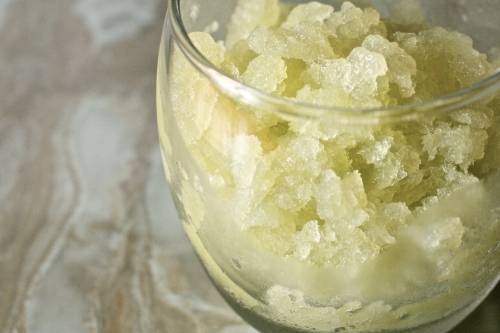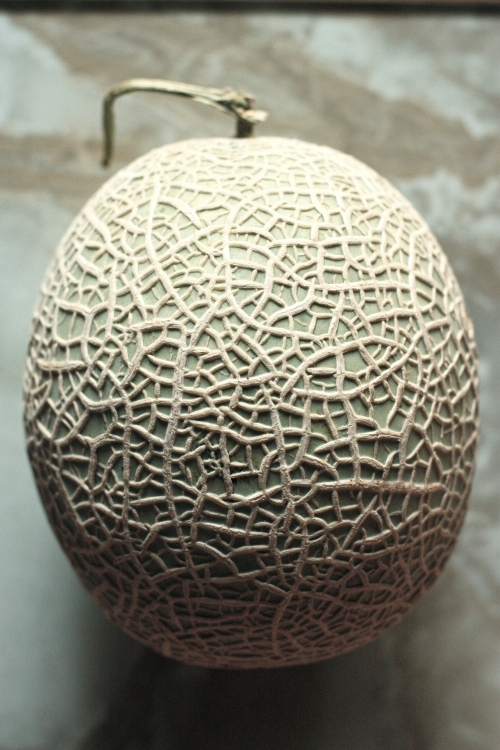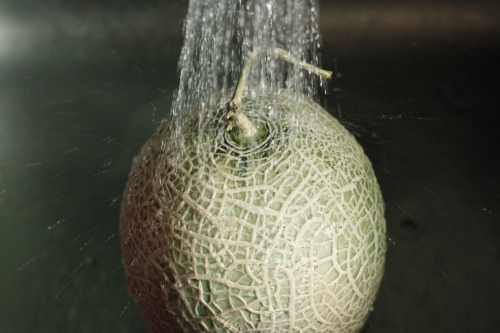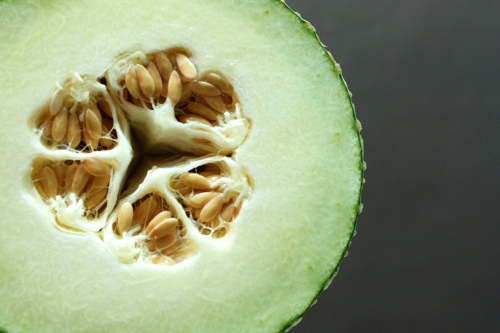Green Melon Granita
by Jacqui
Yesterday afternoon Yaer, Sonj, and I were working on Seoulist in Yaer’s studio when a man with mad scientist hair and big eyeglasses pulled up in his truck, opened the front door, and stuck his head through, all jocular, to make an announcement. He was selling melons, a whole load of them from the bed of his truck. He wore those scratchy white gloves all Korean men who sell fruit from trucks wear, and he had half a melon in one hand. With the other hand, he offered each of us a sample at the tip of his paring knife, pierced like a spear through a fish. Light green, tender and mellow, the fruit was good, but we said yes to his gumption and stellar sales pitch. He picked out three heavy balls of fruit from the bed of his truck, bagged them separately, posed for a photo and drove away.
Since I recently mentioned Russ Parsons’ How to Pick a Peach, I feel like I should say something about the difference between a melon that was harvested too soon and a melon that wasn’t (which I didn’t think about yesterday and only relearned today when I leafed back through this specific chapter). Parsons says rough-skinned melons (like these) that are harvested at the right time will detach neatly from their stems, leaving them behind on the vine. Melons with a layer of textured netting, like cantaloupe, should have outer skin that’s golden in color, not green like the melon we bought yesterday. But we don’t always have access to produce at it’s peak, and so we compromise for the sake of survival. I don’t even know if that makes sense. It’s 98 degrees in our apartment with 3,410 percent humidity, and there’s a threat of a citywide blackout starting tomorrow.
Granita might be the idyllic antidote on days that make us feel like this.
Green Melon Granita
1/2 melon, peeled and seeded, cut into chunks (save the seeds in a separate bowl). Substitute any ripe melon (except watermelon for this specific recipe)
juice of 1 lemon
2 teaspoons sugar
pinch of salt
1/2 cup water
The sweetest part of the melon is around the seeds, and it’s worth it to extract as much juice as you can from the flesh that’s attached to them. Do this by putting the seeds in a fine mesh sieve over a bowl and pushing the liquid through with the back of a wooden spoon. Mix in the lemon juice, sugar and salt until the sugar and salt dissolve. You’ll end up with about 1/2 cup of liquid.
In a blender, puree the melon with the strained melon juice and water. Taste and add more sugar or lemon juice to your preference. Pour into a shallow metal tray and stick in the freezer. After an hour, the edges will start to freeze. At this point, scrape around the frozen edges with a fork and rake through the whole thing. Keep checking every hour, raking through each time, until the mixture resembles delicate, finely crushed ice. Serve frozen with a spoon. If you forget or you don’t have the time to keep checking and your granita freezes solid, take it out of the freezer and let it defrost a bit.




This subtle melon granita sounds amazing, especially on a sweltering day. Thanks for sharing the great recipe
Oh lord, this is gorgeous.